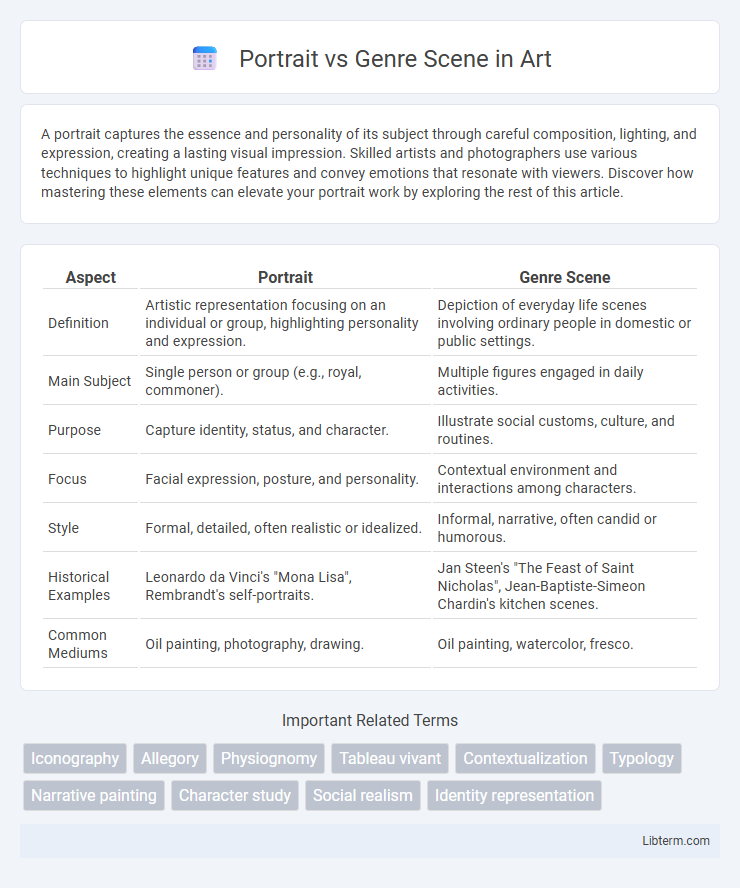A portrait captures the essence and personality of its subject through careful composition, lighting, and expression, creating a lasting visual impression. Skilled artists and photographers use various techniques to highlight unique features and convey emotions that resonate with viewers. Discover how mastering these elements can elevate your portrait work by exploring the rest of this article.
Table of Comparison
| Aspect | Portrait | Genre Scene |
|---|---|---|
| Definition | Artistic representation focusing on an individual or group, highlighting personality and expression. | Depiction of everyday life scenes involving ordinary people in domestic or public settings. |
| Main Subject | Single person or group (e.g., royal, commoner). | Multiple figures engaged in daily activities. |
| Purpose | Capture identity, status, and character. | Illustrate social customs, culture, and routines. |
| Focus | Facial expression, posture, and personality. | Contextual environment and interactions among characters. |
| Style | Formal, detailed, often realistic or idealized. | Informal, narrative, often candid or humorous. |
| Historical Examples | Leonardo da Vinci's "Mona Lisa", Rembrandt's self-portraits. | Jan Steen's "The Feast of Saint Nicholas", Jean-Baptiste-Simeon Chardin's kitchen scenes. |
| Common Mediums | Oil painting, photography, drawing. | Oil painting, watercolor, fresco. |
Understanding Portraits: Definition and Key Features
Portraits are artistic representations primarily focused on capturing the likeness, personality, and mood of an individual or group. Key features include emphasis on facial expressions, detailed attention to anatomical accuracy, and often a neutral or symbolic background to highlight the subject. Unlike genre scenes, which depict everyday life and social interactions, portraits center on identity and personal representation.
Exploring Genre Scenes: What Sets Them Apart
Genre scenes capture everyday life moments, highlighting ordinary people engaged in common activities, creating a narrative that reflects cultural and social contexts. Unlike portraits, which focus on individual identity and character, genre scenes emphasize situational storytelling and collective experience through detailed settings and interactions. These scenes provide rich historical insights and emotional depth by portraying relatable, dynamic environments rather than singular likenesses.
Historical Context: Evolution of Portraits and Genre Scenes
Portraits evolved from medieval religious icons to Renaissance humanist representations, emphasizing individual identity and social status, while genre scenes emerged in the 17th century Dutch Golden Age, reflecting everyday life and domestic settings. This shift paralleled social and economic changes, with portraits serving aristocratic and royal patrons, and genre scenes appealing to the burgeoning middle class. The evolution highlights how art mirrored societal values, moving from idealized depictions of power to more intimate and relatable portrayals of common experiences.
Visual Elements: Composition and Style Differences
Portrait compositions prioritize the subject's face and upper body, using close framing to emphasize individual identity and emotional expression, often with a neutral or blurred background for focus. Genre scenes depict everyday activities with multiple figures, employing wider compositions that capture dynamic interactions and detailed environments, enhancing narrative context. Portrait styles range from formal realism to stylized interpretations emphasizing personality, while genre scenes favor naturalistic, lively depictions that reflect social settings and cultural realities.
Subject Matter: Capturing Individuals vs Depicting Everyday Life
Portrait art centers on capturing the unique features, personality, and emotions of an individual, often highlighting facial expressions and personal identity. Genre scenes depict everyday life by illustrating common activities, social interactions, and cultural customs within familiar settings, emphasizing narrative over individual characterization. The subject matter in portraiture is singular and intimate, while genre scenes offer a broader, communal perspective on ordinary experiences.
Emotional Impact: Personal Connection vs Narrative Engagement
Portraits create a deep emotional impact through personal connection by highlighting individual expressions and unique character traits that evoke empathy and introspection. Genre scenes engage viewers by depicting everyday life moments, stimulating narrative engagement through relatable storytelling and collective experiences. The emotional resonance in portraits centers on intimacy, while genre scenes draw from the dynamic interaction of multiple figures and activities to evoke shared cultural or social contexts.
Techniques and Approaches: Distinct Artistic Methods
Portraiture emphasizes capturing the subject's personality and likeness through precise brushwork, detailed facial expressions, and controlled lighting to highlight individual features. Genre scenes adopt dynamic compositions and broader brushstrokes, using ambient light and context-rich backgrounds to convey everyday life and social interactions. Techniques diverge as portraits prioritize realism and intimacy, while genre scenes focus on narrative depth and spontaneous moments.
Symbolism and Meaning in Portraits and Genre Scenes
Portraits emphasize individual identity and status, often incorporating symbolic elements like clothing, objects, or gestures to convey power, personality, or moral virtues. Genre scenes capture everyday life and social interactions, using symbolic details to reflect cultural norms, communal values, or subtle social critiques. Both genres utilize symbolism to deepen viewers' understanding of personal or societal narratives beyond mere representation.
Famous Artists and Iconic Works in Both Categories
Portrait artists like Leonardo da Vinci with his "Mona Lisa" and Johannes Vermeer with "Girl with a Pearl Earring" capture individual expressions and personalities, emphasizing detailed likeness and character study. Genre scene painters such as Jan Steen, known for "The Feast of Saint Nicholas," and Pieter Bruegel the Elder with "Peasant Wedding," depict everyday life and social narratives, highlighting communal activities and cultural customs. Both categories showcase influential works that have shaped art history by reflecting unique aspects of human experience through distinct visual storytelling.
Choosing Between Portrait and Genre Scene: Artistic Considerations
Choosing between portrait and genre scene hinges on the intended narrative and emotional impact; portraits prioritize individual identity and psychological depth, while genre scenes emphasize everyday life and social context. Artistic considerations include composition complexity, with portraits often requiring focused lighting and detailed facial expression, whereas genre scenes demand dynamic arrangements and interaction between multiple figures. The decision also involves the artist's intent to convey personal character or broader cultural themes, influencing technique and thematic elements accordingly.
Portrait Infographic

 libterm.com
libterm.com